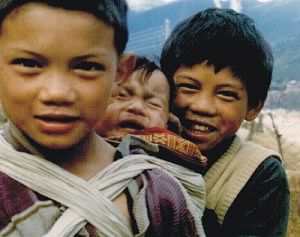FACT
file
The
tsunamis and child trafficking
Children
were one-third of the casualties of the tsunamis, and
those who survived are suffering the worst effects of
their aftermath. Untold thousands have been orphaned or
separated from families. Without protection or caregivers,
they are at greatest risk for starvation and disease.
They are also in danger from human traffickers, who have
long operated in South Asia with near impunity, and who
must have viewed the tsunamis as an opportunity to prey
on the victims. Amazingly, these criminals seem to have
been largely stymied by governments determined to prevent
further tragedy. In a region devoid of cheer, this is
at least a hopeful moment.
 Soon
after the wave hit, Indonesia - where an estimated 35,000
children have lost one or both parents - moved to protect
young people in hard-hit Aceh, barring the departure of
children from that province unless they are accompanied
by verifiable family members. Thailand is doing the same,
and other areas are imposing their own controls. The emphasis
is on finding lost children, registering them and housing
them until they can be reunited with their families. Adoptions
- which can sometimes be a front for trafficking - have
been suspended in several countries. Child protection
officers are making themselves visible in villages.
Soon
after the wave hit, Indonesia - where an estimated 35,000
children have lost one or both parents - moved to protect
young people in hard-hit Aceh, barring the departure of
children from that province unless they are accompanied
by verifiable family members. Thailand is doing the same,
and other areas are imposing their own controls. The emphasis
is on finding lost children, registering them and housing
them until they can be reunited with their families. Adoptions
- which can sometimes be a front for trafficking - have
been suspended in several countries. Child protection
officers are making themselves visible in villages.
These
extraordinary efforts will no doubt save young people
who might otherwise be exported for sale as sex slaves
or sweatshop labor. While estimates vary, the nations
of South Asia are notorious for supplying a large part
of the hundreds of thousands of children trafficked every
year as part of a $12 billion criminal enterprise worldwide.
The
clampdown by countries hit by the tsunamis follows pressure
from the State Department, Unicef and nongovernmental
organizations, like World Vision and Vital Voices, which
have ratcheted up their monitoring and joined efforts
to protect the most vulnerable disaster victims. The enormity
of the tsunamis' impact and attention from a watchful
world seem to have helped local officials get past the
corruption in their ranks and overcome the kind of denial
that has in the past helped give traffickers a pass. As
a result, there have been just a handful of confirmed
reports of post-tsunami child trafficking.
Welcome
as these efforts are, they will mean little unless they
evolve into a region wide commitment to keep up the pressure
to stop child exploitation, not just as part of the recovery
from a disaster, but also as an investment in a collective
future.
Source
: New York Times.